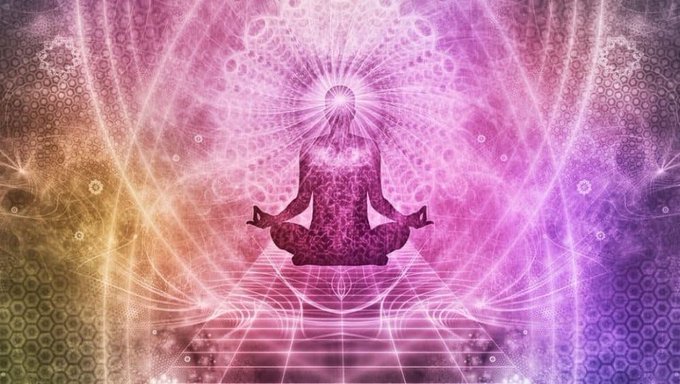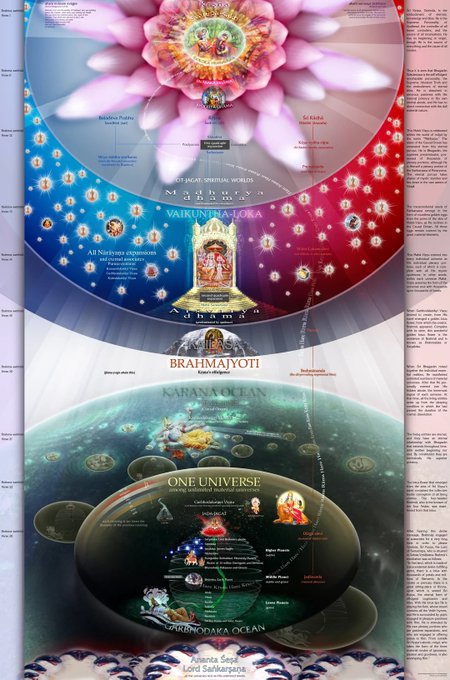Long before modern science discovered the age of the universe…
Hindu sages were already talking about:
- The Big Bang
- Cyclical creation
- Time scales of TRILLIONS of years


Hinduism doesn’t see time as linear. It’s cyclical — creation, sustenance, destruction, and rebirth.
This cycle is known as:
- Srishti (creation)
- Sthiti (preservation)
- Pralaya (dissolution)
The same universe is created and destroyed… again and again. This cycle is not random — it’s mathematically defined in the Vedas and Purāṇas.

The Vishnu Purana (1.3.8–10) and Bhagavata Purana (3.11) lay out a cosmic time scale so vast, it stuns modern minds.
Let’s start with the smallest cosmic unit:
1 Mahāyuga (Chaturyuga) = 4,320,000 years
-
- It includes:
- — Satya Yuga = 17,28,000 years
- — Treta Yuga = 12,96,000 years
- — Dvapara Yuga = 8,64,000 years
- — Kali Yuga = 4,32,000 years
- We are currently in Kali Yuga, which began in 3102 BCE.
- It includes:


1 Kalpa (Day of Brahma) = 1,000 Mahāyugas = 4.32 billion years
Sanskrit: “sahasra-yuga-paryantam ahar yad brahmaṇo viduḥ rātriṁ yuga-sahasrāntaṁ te ’ho-rātra-vido janāḥ” — Bhagavad Gītā 8.17
Translation: A single day of Brahma is equal to 1,000 Yuga cycles (Mahāyugas). So is his night.

1 night of Brahma = 4.32 billion years (inactive phase)
That means 1 full day-night of Brahma = 8.64 billion years
At night, the universe dissolves (pralaya), and remains in a dormant state until the next cycle.
- Here’s a more simplified view —
- 1 human year = 1 day for the Devas
- 1 day of Brahma = 4.32 billion years
- 1 night of Brahma = 4.32 billion years
- 1 full day-night of Brahma = 8.64 billion years
Let that sink in.

Now let’s scale up. Here’s where it gets wild:
- 30 Brahma days = 1 Brahma month = 259.2 billion years
- 12 months = 1 Brahma year = 3.11 trillion years
- Brahma lives 100 years = 311.04 trillion years
That’s how long one cycle of the universe lasts. Then… everything resets.
After this, a new Brahma takes form and the cycle repeats eternally.
This is the Maha-Pralaya, or final dissolution.

And where are we now?
According to Surya Siddhanta and Puranas:
We are in the 51st year of Brahma
In the first day (Shveta Varaha Kalpa) of that year
In the 28th Mahāyuga of the current Kalpa
In the Kali Yuga, which began in 3102 BCE
Meaning this current universe has already existed for over 155 trillion years — in Brahma’s time.


Even the Big Bang theory estimates the universe’s age as 13.8 billion years.
But Hindu cosmology describes a 4.32 billion year cycle within an even bigger framework — repeated again and again.
Science is just catching up.

In 1930s, cosmologists like Georges Lemaître proposed the Big Bang.
But over 5,000 years ago, the Nasadiya Sukta of the Rig Veda (10.129) posed a question:
- “Who truly knows how creation happened?”
- “Perhaps even He from whom the universe emerged does not know…
This is not dogma. It’s humility and cosmic insight.

19th century scholars were stunned
The 19th century scholars were so stunned, French astronomer Jean-Sylvain Bailly wrote:
“The Hindu systems of astronomy are so ancient, that they must have preceded even the oldest Greek systems.”
They couldn’t explain how Hindus knew this.

Quantum physics and cosmology are slowly catching up
Today, quantum physics and cosmology are slowly catching up. Concepts like:
- Multiverse
- Cyclical universes
- Heat death and rebirth
All echo what Hindu seers said thousands of years ago — in the Vedas and Upanishads.


Hindu texts describe the universe as one among infinite universes (Multiverse Theory).
Bhagavata Purana 6.16.37: “ananta-koti brahmāṇḍa”
Translation: “There are countless millions of universes.”


To the rishis, time wasn’t just a number.
It was a cosmic rhythm. An endless dance of creation, dissolution, and rebirth.
What modern science calls theory — Hinduism made part of daily meditation.

This is not mythology.
It’s a deeply spiritual cosmology — rooted in mathematics, meditation, and metaphysics.
No civilization — not the Greeks, not the Egyptians, not the Chinese — came close to this scale of cosmic imagination.
The Big Bang is seen as just the start of one of infinite cycles.
Creation is not a one-time event.


Hindu cosmology doesn’t ask you to believe blindly.
It invites you to explore:
— Look outward through astronomy
— Look inward through meditation
And you’ll realize — the universe was never just “out there.” It’s also within you.
Next time
So the next time someone calls Hinduism “primitive,” remind them:
When the West said Earth was 6,000 years old… Sanātana Dharma had already mapped TRILLIONS.




